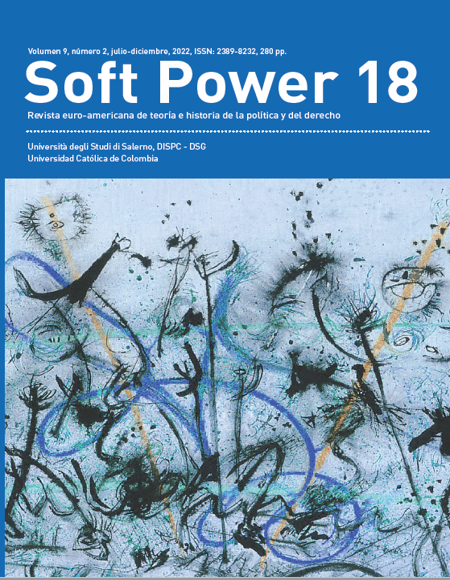
Esta obra está bajo una licencia internacional Creative Commons Atribución-NoComercial 4.0.
Al enviar los artículos para su evaluación, los autores aceptan que transfieren los derechos de publicación a Soft Power. Revista Soft Power para su publicación en cualquier medio. Con el fin de aumentar su visibilidad, los documentos se envían a bases de datos y sistemas de indización, así mismo pueden ser consultados en la página web de la Revista.Resumen
El soberanismo ha sido últimamente muy utilizado en el debate público, especialmente en el contexto de la Unión Europea, a menudo mal utilizado como un simple sinónimo de nacionalismo o populismo y prestando poca atención a los diferentes niveles de análisis. En este artículo intentamos explorar el concepto proponiendo lecturas interpretativas basadas en varios enfoques teóricos, incluyendo la teoría del discurso y la teoría de los clivajes. En particular, tratamos de comprender mejor el concepto de “soberanismo” mediante una comparación de las articulaciones y los vínculos con los conceptos de populismo y nacionalismo. También mostramos los diferentes matices que el concepto de soberanismo ha adquirido en algunos contextos específicos, por ejemplo en Italia, donde se ha convertido en una palabra de moda para los partidos y movimientos de extrema derecha, como la Lega de Matteo Salvini y CasaPound. En
conclusión, reconocemos los importantes elementos de continuidad con el populismo y el nacionalismo, pero también destacamos los elementos que caracterizarían al soberanismo como una ideología propia, como las narrativas basadas en el retorno a un pasado donde la soberanía sería patrimonio exclusivo del pueblo y la nación.

Citas
Adorno, T. W. (1950). The authoritarian personality, New York (Harper & Brothers) 1950.
Bartolini, S., & Mair, P. (2007). Identity, competition and electoral availability: the stabilisation
of European electorates 1885-1985. ECPR Press.
Bascelli, G. (2018). The Erasmus+ Project Strategy. Geopolitical, Social Security and
Freedom Journal, 1(2), 106-118.
Basile, L. & Mazzoleni, O. (Eds.). Sovereignism and Populism. Citizens, Voters and Parties
in Western European Democracies. Abingdon: Routledge.
Bauman, Z. (2017). Retrotopia. Cambridge: Polity Press.
Betz, H. G. (1994). Radical right-wing populism in Western Europe. Springer.
Bornschier, S. & Kriesi, H. (2012). The populist right, the working class, and the changing
face of class politics, in J. Rydgren (ed.), Class Politics and the Radical Right,
London: Routledge, 10–30.
Brooks, C., Nieuwbeerta, P. and Manza, J. (2006). Cleavage-based voting behavior in
cross- national perspective: Evidence from six postwar democracies. Social Science
Research, 35: 88–128.
Bruno, V. A. (2022). “Online use of Slogans, Symbols and Slurs by the Italian Radical
Right”, in V. A. Bruno, T. Hof, M. Kreter and J.-Y. Camus, Symbols & Slogans of the
Radical Right Online: Italy, Germany, France (pp. 2-64). Oxford: ACS. Available at:
https://www.academicconsulting.co.uk/_files/ugd/4775ea_eb523462f5cb43beb4c-
dadbce90ee1.pdf?index=true.
Bugaric, B. (2019). Could populism be good for constitutional democracy?. Annual Review
of Law and Social Science, 15, 41-58.
Castillo-Ortiz, P. (2019). The illiberal abuse of constitutional courts in Europe. European
Constitutional Law Review, 15(1), 48-72.
Chevènement, J.P. (1997). Le Bêtisier de Maastricht, Arléa.
Crouch, C. (2019). The ‘left behind’ and pessimistic nostalgia, Medium, 3 September
Available at https://medium.com/whose-society-whose-cohesion/the-left-behind-
and-pessimistic-nostalgia-d5828833c280.
Dalton, R. J., Flanagan, S. C., and Beck, P. A. (1984). Electoral Change in Advanced Industrial
Democracies: Realignment or Dealignment?, Princeton, NJ: Princeton University
Press.
De Cleen, B. (2017). Populism and Nationalism. In C. Rovira Kaltwasser, P. Taggart,
P. Ochoa Espejo, & P. Ostiguy (Eds.), The Oxford Handbook of Populism (pp. 1-23).
Oxford: Oxford University Press.
Deegan-Krause, K. (2007). New dimensions of political cleavage. In Dalton, Russell J.
and Klingemann, Hans-Dieter (eds.) Oxford Handbook of Political Science, Oxford:
Oxford University Press.
Dujardin, V. (2019). The European Commission 1986-2000: history and memories of an
institution. In E. Bussière, P. Ludlow, F. Romero, D. Schlenker, & A. Varsori (Eds.).
Brussels: Publications Office of the European Union.
Edlund L. and Pande R. (2002). Why Have Women Become Left-Wing? The Political
Gender Gap and the Decline in Marriage, The Quarterly Journal of Economics, Volume
, Issue 3, 917–961.
Flanagan, S. C., & Lee, A. R. (2003). The new politics, culture wars, and the authoritarian-
libertarian value change in advanced industrial democracies. Comparative
Political Studies, 36(3), 235-270.
Foner, A. (1974). Age Stratification and Age Conflict in Political Life. American Sociological
Review, 39(2), 187-196.
Frabbini, S. (2001). Cleavages: Political. International Encyclopedia of Social and Behavioral
Sciences, 1987–1990.
Franklin, M.N. (2010). Cleavage research: A critical appraisal. West European Politics.
(3): 648–658.
Gallagher, M., Laver M. and Mair P. (2011). Representative government in modern Europe.
th edn. New York: McGraw-Hill.
Goldberg, A. C. (2016). The impact of cleavages on Swiss voting behaviour: A modern
research approach. Springer.
Golder, M. (2016). Far right parties in Europe. Annu. Rev. Polit. Sci. 19, 477–497.
Goodliffe, G. (2015). Europe’s salience and ‘owning’Euroscepticism: Explaining the
Front National’s victory in the 2014 European elections in France. French Politics,
(4), 324-345.
Hawkins, K. A., & Rovira Kaltwasser, C. (2017). What the (ideational) study of populism
can teach us, and what it can’t. Swiss Political Science Review, 23(4), 526-542.
Heinisch, R. (2003). Success in opposition–failure in government: explaining the performance
of right-wing populist parties in public office. West European Politics, 26(3),
-130.
Hooghe, L., & Marks, G. (2009). A postfunctionalist theory of European integration:
From permissive consensus to constraining dissensus. British journal of political science,
(1), 1-23.
Hooghe, L., & Marks, G. (2018). Cleavage theory meets Europe’s crises: Lipset, Rokkan,
and the transnational cleavage. Journal of European public policy, 25(1), 109-135.
Huber, R. A., & Schimpf, C. H. (2017). On the distinct effects of left-wing and rightwing
populism on democratic quality. Politics and Governance, 5(4), 146-165.
Inglehart R. (1977). The silent revolution: changing values and political styles among
Western publics, Princeton: Princeton University Press.
Inglehart R. (1984). The Changing Structure of Political Cleavages in Western Society,
in Dalton R.J and Flanagan S.E. Electoral Change Advanced Industrial Democracies:
Realignment or Dealignment?, Princeton, N.J. : Princeton University Press.
Inglehart, R. (1990). Culture Shift in Advanced Industrial Societies. Princeton: Princeton
University Press.
Ivaldi, G. (2018). Contesting the EU in times of crisis: The Front National and politics of
Euroscepticism in France. Politics, 38(3), 278-294.
Kriesi H., Grande E., Lachat R., Dolezal M., Bronshier S., Frey T., (2006). Globalization
and the Transformation of the National Political Space: Six European Countries
Compared, European Journal of Political Research, 45(6), 921-956.
Kriesi, H. (1993). Political Mobilization and Social Change: The Dutch Case in Comparative
Perspective. Aldershot: Avebury.
Kriesi, H. (2010). Restructuration of partisan politics and the emergence of a new cleavage
based on values. West European Politics, 33(3), 673-685.
Kuhn, T. (2015). Being and Feeling European: The Effect of Individual Transnationalism
on EU Support and European Identity. In (eds) Experiencing European integration:
Transnational lives and European identity. OUP Oxford.
Kuhn, T., van Elsas, E., Hakhverdian, A. and van der Brug, W. (2016). An ever wider gap
in an ever closer union: rising inequalities and euroscepticism in 12 west european
democracies, 1975–2009, Socio-Economic Review 14(1): 27–45.
Lachat, R. (2007). A heterogeneous electorate: Political sophistication, predisposition
strength and the voting decision process. Baden-Baden: Nomos.
Lipset S. M. and Rokkan S. (1967). Cleavage structures, Party Systems and Voter Alignments:
An Introduction, in Party Systems and Voter Alignments, New York: The Free
Press, 1-64.
Lipset, S. M. (1971). Youth and politics in Robert K Merton and Robert Nisbet (eds.),
Contemporary Social Problems, New York: Harcourt Brace Jovanovich, Inc, 743-791
Mair, P. (2006). Cleavages, in Katz R.S. and Crotty W.J., Handbook of party politics, London:
Sage.
Marks G., Attewell D., Hooghe L. and Rovny J. (2020). Cleavage Theory, in Riddervold
M., Trondal J., and Newsome A. (eds) Palgrave Handbook on EU Crises, London:
Palgrave MacMillan.
Marks, G., Attewell, D., Rovny, J., & Hooghe, L. (2017). Dealignment meets cleavage
theory. In American Political Science Association Meeting, San Francisco, CA (Vol.
.
Marks, G., Wilson, C. J., & Ray, L. (2002). National political parties and European integration.
American Journal of Political Science, 585-594.
Milner, H. (2020). Populism and political knowledge: The United States in comparative
perspective. Politics and Governance, 8(1), 226–238.
Mudde, C. (2004). The populist zeitgeist. Government and opposition, 39(4), 541-563.
Mudde, C. (2007). Populist radical right parties in Europe. Cambridge: Cambridge university
press.
Mudde, C. (2013). Three decades of populist radical right parties in Western Europe: So
what?. European Journal of Political Research, 52(1), 1-19.
Mudde, C. (2014). Fighting the system? Populist radical right parties and party system
change. Party Politics, 20(2), 217-226.
Mueller, S., & Heidelberger, A. (2020). Should we stay or should we join? 30 years of
Sovereignism and direct democracy in Switzerland. European Politics and Society,
(2), 182-201.
Norris, P., & Inglehart, R. (2019). Cultural backlash: Trump, Brexit, and authoritarian
populism. Cambridge University Press.
Rokkan, S. (1999). State formation, nation-building, and mass politics in Europe: the theory
of Stein Rokkan: based on his collected works. Clarendon Press.
Rovny, J. (2013). Where do radical right parties stand? Position blurring in multidimensional
competition. European Political Science Review, 5(1), 1-26.
Rydgren, J. (2007). The sociology of the radical right. Annu. Rev. Sociol., 33, 241-262.
Rydgren, J. (2018). The Oxford Handbook of the Radical Right, Oxford: Oxford University
Press.
Samuk, S., Nienaber, B., Kmiotek-Meier, E., Vysotskaya, V., Skrobanek, J., Ardic, T., &
Muresan, L. (2021). Learning in transition: Erasmus+ as an opportunity for internationalization.
In Cairns, D. (eds). The Palgrave Handbook of Youth Mobility and
Educational Migration. Springer Nature.
Schwörer, J. and Fernández-García, B. (2020). ‘Religion on the rise again? A longitudinal
analysis of religious dimensions in election manifestos of Western European
parties’, Party Politics.
Scopelliti, A. (2020). Authoritarian Populism, Emancipatory Populism: The Italian Constitutional
Referendum. Centre for Analysis of the Radical Right. Available at: https://
www.radicalrightanalysis.com/2019/12/18/the-role-of-souverainisme-for-european-
radical-extreme-right-parties/. (Accessed: 24/10/2022).
Scopelliti, A. (2021). The CARR Interview Series: Alessio Scopelliti. Centre for Analysis
of the Radical Right. Available at: https://www.radicalrightanalysis.com/2021/12/07/
the-carr-interview-series-alessio-scopelliti/. (Accessed: 24/10/2022).
Spruyt, B., Keppens, G., & Van Droogenbroeck, F. (2016). Who supports populism and
what attracts people to it? Political Research Quarterly, 69(2), 335–346.
Staerklé, C., & Green, E. G. (2018). Right‐wing populism as a social representation: A
comparison across four European countries. Journal of Community & Applied Social
Psychology, 28(6), 430-445.
Thériault, J. Y. (1994). L’individualisme démocratique et le projet souverainiste. Sociologie
et sociétés, 26:2, 19–32.
Triandafyllidou, A. (1998). National identity and the’other’. Ethnic and racial studies,
(4), 593-612.
Urbinati, N. (2019). Me the people. Harvard University Press.
Varsori, A. (2020). Euroscepticism and European Integration: A Historical Appraisal.
In Euroscepticisms (pp. 10-32). Brill.
Vasilopoulou, S. (2018). Far right parties and Euroscepticism: Patterns of opposition.
Rowman & Littlefield International, Limited.
Vassallo, S., & Valbruzzi, M. (2018). I partiti della Grande Recessione contro i partiti
della Grande Depressione. Un nuovo cleavage o un’altra bolla?. Stato e mercato,
(1), 87-116.
Verzichelli, L. (2021). Conclusions. The populism-sovereignism linkage: findings,
theoretical implications and a new research agenda. In L. Basile & O. Mazzoleni
(Eds.), Sovereignism and Populism. Citizens, Voters and Parties in Western European
Democracies (pp. 108-120). Abingdon: Routledge.
Von Schoultz A. (2017). Party Systems and Voter Alignments, in Sage Handbook of
Electoral Behaviour eds (Kai Arzheimer, Jocelyn Evans, Michael S. Lewis-Beck),
Sage Publishers.
Wintrobe R. (2018), An economic theory of a hybrid (competitive authoritarian or illiberal)
regime, Public Choice, 177(3–4), 217–233.
Zuckerman, A. (1975). Political cleavage: A conceptual and theoretical analysis. British
Journal of Political Science, 5(2), 231-248.









